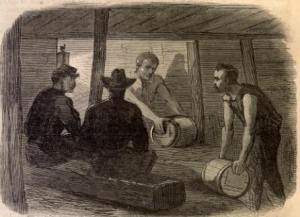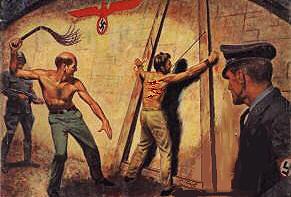
BY THE END OF 1914, the trench warfare on the Western Front had bogged down into a bloody stalemate. But the German army thought it had come up with a scheme to break the impasse.
On Dec. 21 the Kaiser’s troops detonated ten explosive charges beneath a segment of the British trenches at Givenchy, France. The Germans were able to place the explosives directly beneath the feet of the defenders after digging a series of tunnels from their positions to the British line. When detonated, the 50kg charges created the desired effect – confusion. As many as 800 Indian troops died in the ensuing assault.
The use of tunnels in this way might have seemed like a revolutionary new strategy in 1914. But it had actually been used in a number of recent wars as well as several sieges throughout history, some as far back as ancient times. But those first forays underground were anything but successful. In fact, some of the earlier attempts at subterranean warfare ended up being more dangerous for the tunnelers than anyone else.
In the 2nd Century BC, Romans tried tunneling in their siege of the Aetolian city of Ambracia. The plan was to dig right into the city and launch an assault from within the defenders’ own stronghold. The legions spent days digging, carefully concealing the growing mounds of excavated earth. Eventually, the Aetolians figured out what the Romans were up to and dug a tunnel of their own to intercept the attackers’ own passageway. Upon reaching the Roman shaft, the Aetolians filled the tunnels with smoke from burning feathers and suffocated the Romans.
In the era of the medieval castle, armies frequently tunneled beneath enemy fortifications to ‘mine’(shorthand for ‘undermine’) the walls. After digging to a point beneath an opponent’s walls, enormous spaces would be hollowed out that were then supported by large timber props. When all was ready, fires would be set to burn through the wooden supports. The resulting cave-in would collapse the tunnel, possibly bringing the walls down too. This would create a breech that the besiegers could rush forward to exploit.
These strategies were used in a number of sieges in the 13th Century, specifically at Rochester Castle in 1215, Dover in 1216 and Dryslwyn in 1287.
To prevent tunneling, architects would often build castles on rocky terrain that couldn’t be excavated. Conversely, wet marshy land, or constructing keeps or fortresses near bodies of water made digging equally impossible.
Military tunneling was all but abandoned after the age of the castle, but it was reintroduced in the 19th Century when fixed fortifications again became a more common feature of warfare.

During the American Civil War, Union armies employed massive subterranean mines unsuccessfully to break up rebel defenses at Vicksberg in 1863.
But an even more ambitious attempt occurred the following year as the North tried to force an end to the siege of Petersburg.
Union engineers excavated a 3 x 4.5 foot shaft that ran 500 feet directly towards Confederate fortifications surrounding the city. Once beneath the rebel line, engineers hollowed out a gallery that ran nearly 40 feet out in either direction from the end of the main shaft. Some 320 kegs of gunpowder (4 tons of it) were placed in the passages a scant 20 feet below the defenders’ feet. Just before 5 a.m. on July 30, the kegs went up in a deafening explosion that instantly killed nearly 300 rebel troops. The blast carved out a 30-foot deep crater that was 170 feet across. Delays in the follow up attack prevented the Union from exploiting the confusion. When Northern troops finally did push forward, they foolishly charged right into the giant pit and were mowed down by the reorganized defenders. This “Battle of the Crater” was an unmitigated disaster for the Union. More than 500 federal troops were killed and the rebels continued to hold Petersburg.
A similar but larger attempt at mining was undertaken by the British in the First World War. But the plan to blast apart German defenses at the 1917 Battle of Messines was much more successful.
For more than a year, 21 saps were dug beneath a 17,000-yard long line of German trenches. The passages, which were hollowed out by British, Canadian and Anzac miners, were packed with more than 450 tons of high explosives (nearly one million pounds!) When all was ready, nine infantry divisions were brought forward. Their mission was to dart across no mans land to capture the German-held ridge as soon as the mines were set off.
In the hours before the June 7 blast, the British commander of the operation joked that the plan “may not make history, but it will certainly change the geography.”
The explosion was coordinated to follow a massive artillery barrage. When the bombardment ceased, German troops swarmed back into their forward trenches to repel the expected infantry assault across no man’s land. It didn’t come.
Instead, ten minutes later, the mines exploded creating the largest wartime non-nuclear blast in history. More than 10,000 German troops were vaporized in the detonation*, which was reportedly heard in London and felt as far away as Dublin. A series of 250-foot-wide craters broke apart the enemy defences. The British troops surged forward and captured the ridge.
As warfare has become more mobile, tunnelling has once more been forgotten… or has it? In 1990, the South Korean military stumbled across a large tunnel being excavated by communist forces beneath the 38th Parallel. The passage way was wide enough for up to 2000 troops to pass through per hour. It was the fourth such North Korean tunnel discovered since the 1970s. Pyongyang claimed the concrete reinforced passages were for coal mining.










I always found it amazing how many paralells there were between the later stages of the ACW and WWI. And how sad it was, since most of the participants had forgotten the lessons learned during ACW trench warfare and kept on making the same mistakes over and over again, feeding thousands into a meat grinder.
BTW… there are at least two of the Messines Bombs that are unexploded… a third went of in July 1955 killing only a cow. The farmer living above one of the unexploded ones seems to be quiet unconcerned though:
http://www.rense.com/general47/50000lbWW1bomb.htm
Great link… my research indicates 10,000 Germans perished in the blast. This story indicates 6000. I thought 10K sounded a bit too high. Thanks for that.